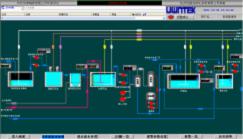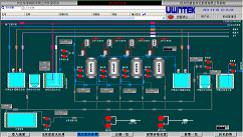1. Project Overview
With the continuous expansion of enterprise scale and product diversification, it is increasingly important to improve process operations and process control, fully tap technology and management potential, create better economic benefits, and realize the automation and scientificization of management and decision-making. The integration of automation technology and information technology Application is an urgent need for the development of pharmaceutical companies.
This project focuses on the key industrial equipment or industrial processes in the biochemical process, such as fermentation tanks, reactors, extraction tanks, evaporators, etc., to summarize, refine and evaluate soft measurement, process control, process optimization, system integration and engineering applications. Finally, Form a complete set of special control systems for biochemical processes, and implement them by category and unit to obtain better economic benefits for unit equipment; then, build a production scheduling and production management system to realize prescription management, batch production scheduling, production line management, and batch tracking and safety management, optimize the production process of a single variety, and further achieve multi-variety coordination to obtain overall economic benefits. Finally, a plant-wide information management system was established to achieve comprehensive automation.
2. Main functions and technical indicators
1) A complete set of dedicated control systems for the biological fermentation process. Including 1) biological fermentation process parameter measurement system: fermentation tank temperature T, fermentation tank pressure P, fermentation liquid volume V, air flow FA, cooling water inlet and outlet temperatures T1 and T2, stirring motor speed RPM, stirring motor current I, foam height Physical parameters of the fermentation process such as H; chemical parameters of the fermentation process such as pH value and dissolved oxygen concentration Do; biomass respiratory metabolism parameters, biomass concentration, metabolite concentration, substrate concentration, and biological specific growth rate, substrate consumption rate and product formation Fermentation process biological parameters such as rate. 2) Conventional control system for biological fermentation process: defoaming control, tank temperature control, tank pressure control, pH control, dissolved oxygen control, feeding control, etc. 3) Biological fermentation process modeling, advanced control and optimization: optimization curve control of pH and reaction temperature, culture medium addition process optimization strategy, transfer process optimization strategy, etc.
2) A complete set of dedicated control systems for the synthesis reaction process. An intermittent control system that integrates intermittent production management and intermittent production process control with the goal of optimizing the comprehensive economic indicators of the intermittent production process. In addition to all the functions of the program intermittent control system, it also has functions such as recipe processing, process optimization, online or offline statistical process control, batch production management, planning and scheduling, and energy management.
3) A complete set of special control systems for the extraction process of traditional Chinese medicine: The modern preparation process of traditional Chinese medicine includes: medicinal materials -> water washing -> drying -> chopping -> water extraction three times -> filtration -> resin adsorption -> water washing -> elution -> Concentration under reduced pressure->Alcohol precipitation->Filtration->Concentration under reduced pressure->Low temperature drying or spray drying->Finished product; the extraction and production process of traditional Chinese medicine is based on GMP specifications and the process of producing a certain amount of products according to a given formula. Typical intermittent production process. Its main characteristics are: small batches and multiple varieties, which are characterized by: discontinuity of material flow, unsteadiness of materials and equipment, uncertainty of products and their processes, and dynamic scheduling and allocation of equipment resources. Including traditional Chinese medicine extraction process sequence control, discrete control, regulatory control, formula processing, equipment management, production scheduling and tracking functions, operation optimization, etc.
4) MES Manufacturing Execution System: Based on the process control system and the pharmaceutical enterprise integrated information platform based on the unstructured data management system, a production scheduling and production management system is constructed to realize prescription management, batch production scheduling, production line management, and batch tracking. and safety management, etc., to optimize the production process of a single variety, and further achieve multi-variety coordination to obtain the best overall economic benefits.
5) ERP enterprise resource management system: Establish a factory-wide information network system to realize information exchange from sensors to conference rooms, locate the data of any object from object to object through the network, and integrate the factory into a unified system from process parameter detection to business information system Overall; realize comprehensive automation of enterprises, including: office automation system, formula management system, human resources management system, general department management system, sales management system, procurement management system, inventory management system, template design system, system management system, safety management system, master production planning, rough capacity planning, material requirements planning, fine capacity planning, production operation control, branch factory management, and process control system data integration application system.
3. Technological innovation
1) Use advanced control, equipment modeling, and process optimization technologies to realize a complete set of dedicated control systems for the biological fermentation process, a complete set of dedicated control systems for the synthesis reaction process, and a complete set of dedicated control systems for the extraction process of traditional Chinese medicine;
2) Provide a customizable and scalable pharmaceutical industry control engineering industry algorithm library, and continuously refine expert knowledge and engineering experience through design institutes, equipment manufacturers, engineering companies, and industry users to continuously enrich the industry automation professional knowledge base, with domain knowledge as the main body , supported by an architecture platform with reusable resources and reconfigurable systems, and based on unified modeling specifications, through inheritance, derivation, reuse, and reconstruction mechanisms, the efficiency of project engineering design and programming development can be significantly improved;
3) Develop and implement a variety of network driver hardware modules, use open and standardized OPC client and server interfaces, and use transparent network management technology to achieve data communication with third-party devices, build a real-time database of distributed engineering objects, and realize system data and external devices The global consistency and unified interface of data meet the information integration and interface opening requirements of multi-real-time, multi-semantic, multi-temporal and multi-scale industrial data; based on the real-time database, the network interconnection and intelligent equipment of pharmaceutical enterprise units are realized. Data interface.
4. Application fields and effects of use


A pharmaceutical company uses the UW500 distributed control system and its UWinTech control engineering application software platform to achieve comprehensive automation. First, process control is carried out by category and unit: complete parameter detection and stable control of important production units such as fermentation tanks and reactors, and establish a unit control system to maximize the effectiveness of each process equipment; including fermentation workshops, synthesis workshops, and thermal power plants Automation transformation, scientific research center, three waste treatment, etc.; then, build a production scheduling and production management system to realize prescription management, batch production scheduling, production line management, batch tracking and safety management, etc., optimize the production process of a single variety, and further Achieve multi-variety coordination; finally, realize enterprise comprehensive automation. After the implementation of the comprehensive automation system, the production level of fermentation and post-extraction has been greatly improved; the bacterial contamination rate has been further reduced; the consumption of main and auxiliary raw materials has also been reduced, the comprehensive cost of products has dropped by more than 10% per year, and the cost of raw material procurement has dropped by more than 6% per year. Sales Income increases by more than 20% every year; economic benefits are significant.
